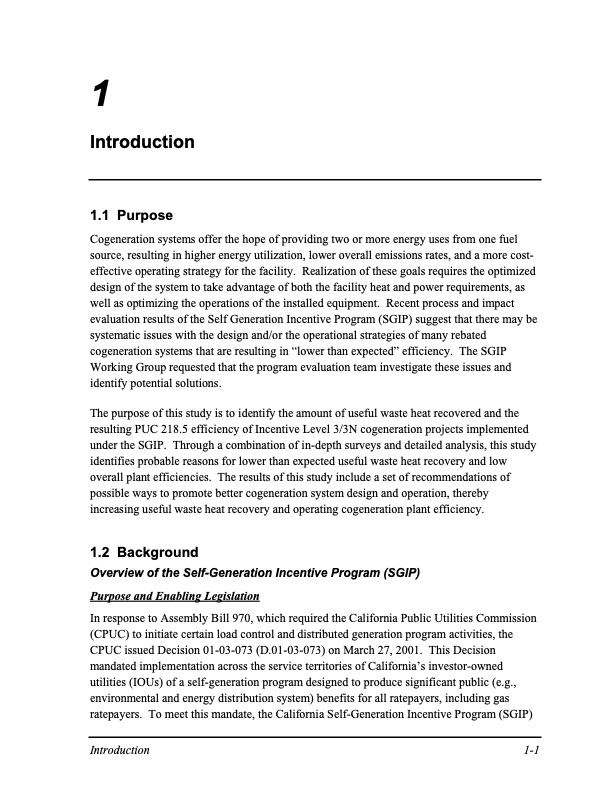
PDF Publication Title:
Text from PDF Page: 009
1 Introduction 1.1 Purpose Cogeneration systems offer the hope of providing two or more energy uses from one fuel source, resulting in higher energy utilization, lower overall emissions rates, and a more cost- effective operating strategy for the facility. Realization of these goals requires the optimized design of the system to take advantage of both the facility heat and power requirements, as well as optimizing the operations of the installed equipment. Recent process and impact evaluation results of the Self Generation Incentive Program (SGIP) suggest that there may be systematic issues with the design and/or the operational strategies of many rebated cogeneration systems that are resulting in “lower than expected” efficiency. The SGIP Working Group requested that the program evaluation team investigate these issues and identify potential solutions. The purpose of this study is to identify the amount of useful waste heat recovered and the resulting PUC 218.5 efficiency of Incentive Level 3/3N cogeneration projects implemented under the SGIP. Through a combination of in-depth surveys and detailed analysis, this study identifies probable reasons for lower than expected useful waste heat recovery and low overall plant efficiencies. The results of this study include a set of recommendations of possible ways to promote better cogeneration system design and operation, thereby increasing useful waste heat recovery and operating cogeneration plant efficiency. 1.2 Background Overview of the Self-Generation Incentive Program (SGIP) Purpose and Enabling Legislation In response to Assembly Bill 970, which required the California Public Utilities Commission (CPUC) to initiate certain load control and distributed generation program activities, the CPUC issued Decision 01-03-073 (D.01-03-073) on March 27, 2001. This Decision mandated implementation across the service territories of California’s investor-owned utilities (IOUs) of a self-generation program designed to produce significant public (e.g., environmental and energy distribution system) benefits for all ratepayers, including gas ratepayers. To meet this mandate, the California Self-Generation Incentive Program (SGIP) Introduction 1-1PDF Image | In-Depth Analysis of Useful Waste Heat Recovery and Performance of Level 3/3N Systems

PDF Search Title:
In-Depth Analysis of Useful Waste Heat Recovery and Performance of Level 3/3N SystemsOriginal File Name Searched:
SGIP_ThermalAnalysisReport.pdfDIY PDF Search: Google It | Yahoo | Bing
Capstone Turbine and Microturbine: Capstone microturbines used and new surplus for sale listing More Info
Consulting and Strategy Services: Need help with Capstone Turbine, sizing systems, applications, or renewable energy strategy, we are here to assist More Info
Container Lumber Dry Kiln: Since 1991 developing and innovating dry kilns using standard shipping containers More Info
Supercritical CO2 Lumber Dry Kiln: Compact fast drying in 3 days or less for small amounts of wood and lumber drying More Info
BitCoin Mining: Bitcoin Mining and Cryptocurrency... More Info
Publications: Capstone Turbine publications for microturbine and distributed energy More Info
FileMaker Software for Renewable Energy Developing database software for the renewable energy industry More Info
CO2 Gas to Liquids On-Demand Production Cart Developing a supercritical CO2 to alcohol on-demand production system (via Nafion reverse fuel cell) More Info
Stranded Gas for low cost power Bitcoin Mining Using stranded gas for generators may provide breakthrough low power costs for cryptocurrency miners. More Info
| CONTACT TEL: 608-238-6001 Email: greg@globalmicroturbine.com | RSS | AMP |